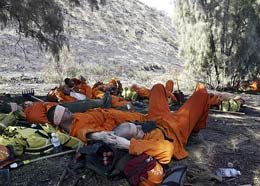| Editor’s note: You can now check out the second part of Barriers to an Effective Rehab Sector. |
By David Jaslow
|
|
Firefighter rehabilitation is commonly mistaken as an operations function owned by the EMS sector. However, it’s actually a logistics function, which comes under two branches – service and supply.
There are many reasons why the rehabilitation and medical monitoring sector has historically been off the radar screen in many fire departments.
The fire service, with its rugged personalities and penchant for heroics, has traditionally been relatively silent about health and wellness issues. A major reason for this is the fact that many of the concepts championed by medical personnel who staff this sector are related to personal behaviors.
Changing behavior is difficult. Denial, blame, ignorance and minimalization are avoidance strategies that effectively block one’s mind from having to address these problematic behaviors.
For the remainder of the year, this column will focus on some of the reasons why implementation of the rehab process is difficult and what actions can be taken to improve the chances for its success.
When I teach EMS providers how to examine patients in the field, I often say, “You will not find what you can not see,” to convey the importance of undressing the patient to the degree necessary to properly perform physical diagnostics
My phrase also holds true when discussing one reason why the establishment of an effective rehabilitation and medical monitoring sector can prove difficult at many incident scenes. Adults are visual learners; we form associations with certain situations and burn a picture into our brains for future reference.
Concept stressed
I stress to fire and EMS officers who become overly concerned with the defining of rehab in terms of toys and technology that rehab is a concept. The most important part of the process is the process itself, not how many misting devices, camp chairs or cooling jackets are available. That being said, there are a few pieces of hardware that will make life easier and increase the chances of deploying a functional rehab sector.
In my opinion, one of the most important pieces of equipment is a flag or other marker to stake at the sector location. It’s not enough to get on the radio and announce on a dedicated incident channel that personnel must report to rehab. As visual learners, rehab exists because your eyes see something labeled “rehab.” It becomes impossible to deny that such a sector exists when you are staring at it.
Furthermore, our confidence levels will be inspired if the sector appears to have form and a purpose. Even just a flag makes it appear to have been built in such a fashion that it is ready to accept firefighters and provide necessary services.
Commercially available devices, such as flags, signs, banners or flashing lights can be purchased or hand-made to mark the rehab and medical monitoring sector. In the mid-1990s, I purchased this Ferno flag for use at major incidents to which I responded as part of the District of Columbia Fire and EMS Department.
While the exact color is more personal preference than evidence-based, some colors are probably best left alone. White signifies surrender, a concept that we do not want to promote. Red is over utilized in emergency services and green is reserved for the incident command post. Curiously in Pennsylvania, many funeral directors place purple revolving lights on the lead car in a procession, although such a color is rarely visible in the daytime sun.
In summary, “build it and they will come” is not a guarantee, but it is far more likely that the rehab sector will be utilized if its appearance is well marked, professional and established early enough to actually provide the rest and rehydration necessary within the first 60 minutes of active firefighting.
View the marking of the sector as a form of advertising. Clearly, advertising pays off or we would not be inundated with it in this country. It’s about time that we as the fire service medical community advertise that we care about our fire and emergency services personnel and we are not afraid to show our true colors!
Read Barriers to an Effective Rehab Sector – Part 2 |
 |
David Jaslow, MD, MPH, FAAEM is a board certified emergency physician who is fellowship trained in EMS and disaster medicine. He is the director of the Division of EMS and Disaster Medicine within the Department of Emergency Medicine at Albert Einstein Medical Center in Philadelphia. Dr. Jaslow is a state-certified Firefighter I and he is credentialed by the Pennsylvania Department of Health as a pre-hospital physician. He functions as a chief officer in several suburban Philadelphia fire and EMS agencies and provides medical oversight as the lead physician for the Bucks County Technical Rescue Task Force as well as Pa. Task Force-1 Urban Search and Rescue.


